News

News 1
ETRI-F&U Credit Information Co., Ltd., Opens a New Path for AI-Based Professional Consultation
- Improved work efficiency of counselors using AI-based counseling support solutions
- Opening possibilities for a more specific counseling experience that can suit the varying purpose of clients
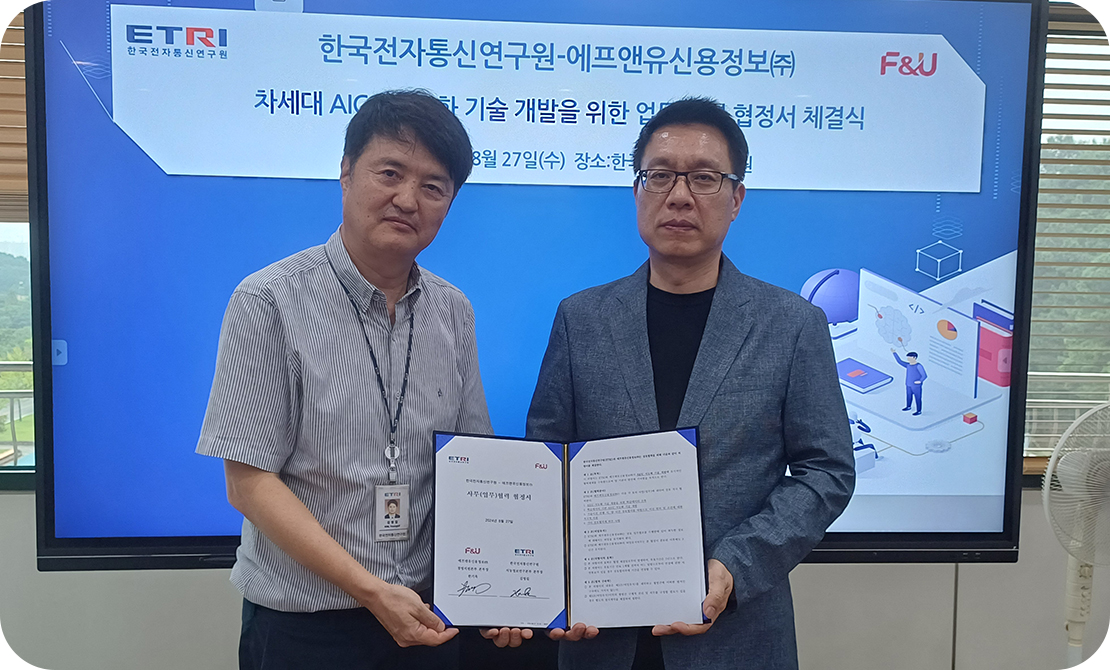
A group of South Korean researchers has decided to utilize AI technology to support customer counseling services. Through this, it will provide a significant boost to the performance and efficiency of counselors in various industries, while improving the overall quality of customer counseling services, ultimately making it easier to meet the customers’ needs and expectations while opening up the possibility for realizing new values.
Electronics and Telecommunications Research Institute (ETRI) announced that at the end of August, they reached an agreement to cooperate with F&U Credit Information Co., Ltd., a company that specializes in customer management & consultation, to develop a new AI-based technology to support next-generation counseling.
ETRI explained that their partnership with F&U was crucial considering the rapid growth of the AICC (Artificial Intelligence Contact Center)1) market in Korea, and both parties felt the need to preoccupy the market. They’ve also stated that they are expecting a positive synergy by combining ETRI’s state-of-the-art AI technology and F&U Credit Information’s extensive know-how in the field of finances.
Counseling support AI technology focuses largely on four key areas: 1) Counseling Summary, 2) Counseling Evaluation, 3) Counseling Classification, and 4) Knowledge Provision based on Retrieval-Augmented Generation2). Through this partnership, both organizations shall cooperate to develop an AI-based counseling support technology that can enable innovation in the current counseling environment.
For example, when a customer wants to receive finance-related counseling service, the counseling support AI technology, based on the 4 key areas mentioned above, is expected to enable a more effective and systematic counseling session. As such, the scope of customer service and counseling can be expanded into various fields other than finance.
Moreover, the research team explained that counselors will be able to explain specific cases to their customers in a shorter time with more accuracy while better suiting the customer’s purpose of consultation.
F&U Credit Information Co., Ltd. shall build and provide a database necessary for learning and evaluation based on their extensive counseling know-how in the field of finances, while ETRI will develop an advanced counseling support technology based on the provided database using their state-of-the-art AI technology.
This year, both parties are planning to conduct a Proof-of-Concept (PoC) for technology verification, then they will cooperate with each other with the common aim of internalizing and commercializing the technology in the future through technology transfer.
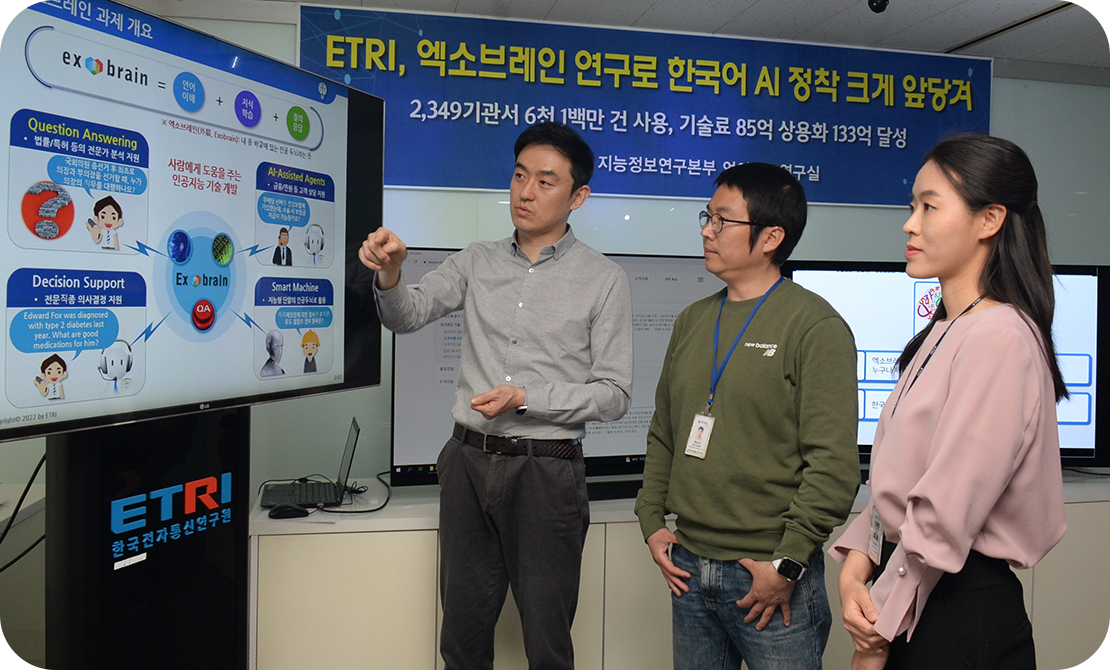
ETRI currently owns an AI source technology that can solve complex problems entered by users, explaining the basis of their judgment and finding out whether the information is true or not.
The ETRI research team plan to develop a next-gen counseling support technology to improve overall work efficiency and strengthen the capabilities of professional counselors through a series of core AI technologies they have accumulated over the years.
Kwon Oh-Wook, the Director of ETRI’s Language Intelligence Research Section, stated in an interview, “Through this partnership with F&U Credit Information, our AI source technology will be further advanced to efficiently help professional counselors at the field with their work, improving their overall efficiency and performance.”
Han Ki-Wook, the Head of the Management Support Division of F&U Credit Information Co., Ltd., also added, “It is our goal to provide BPO3) services with higher quality standards through AICC. We hope to provide our customers with a more efficient, helpful series of consultation services by creating a harmonious chain between our counselors and AICC.”
The research team expects that this cooperation between the two parties will contribute to the establishment of a super-intelligent information society that allows the co-existence between AI and human while minimizing the side effects of AI.
According to Allied Market Research, a global research firm, the market size of the Korean AICC industry was around $42.14 million in 2020, and is expected to reach a whopping $350 million (CAGR of 23.7%) by the year 2030.
This partnership was based on the results of the ‘Development of Explainable Expert Decision Support AI Technology,’ which is a part of the ‘People-Centered AI Core Source Technology Development Project,’ supported by the Ministry of Science and ICT and the Institute for Information & Communication Technology Planning & Evaluation (IITP).
Glossary
1) Artificial Intelligence Contact Center (AICC): A customer service center using AI. Good for streamlining customer service tasks and reduce labor costs.
2) Retrieval-Augmented Generation (RAG): A method that can be used to ensure the reliability of responses by searching and referencing reliable external knowledge DBs/sources before generating answers/texts to inputs made in large language models (LLMs).
3) Business Process Outsourcing (BPO): A business practice in which an organization hires another company to perform specific process work/tasks required for its own business to operate successfully.
Kyungman Bae, Senior Researcher
Language Intelligence Research Section
(+82-42-860-5893, kyoungman.bae@etri.re.kr)
News 2
ETRI, Developing Core Technologies to Secure a Leading Position in 6G Communication
- Absolute Time Synchronous Wireless Access Technology for an Ultra-Precision Real-Time Service
- Wireless Backhaul Technology to overcome the frequency band limits for large-capacity data transmission
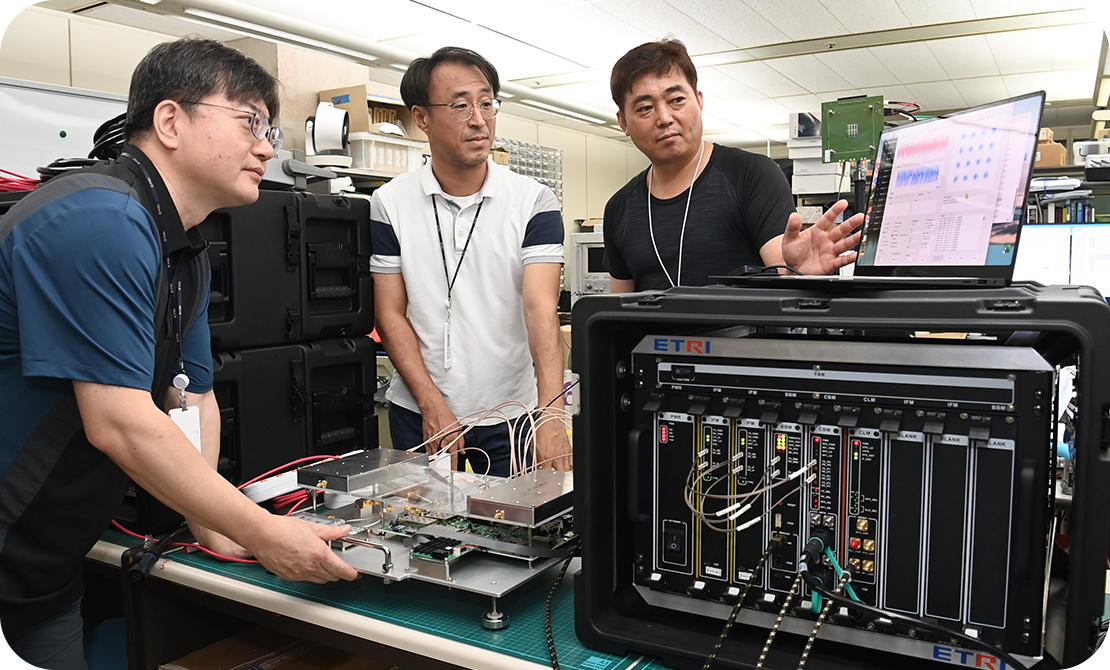
Researchers of South Korea have recently begun to develop a large-capacity, ultra-precision technology that can be used for the implementation of next-gen mobile communication.
Electronics and Telecommunications Research Institute (ETRI) announced that they will develop new key technologies for wireless access and wireless backhauling to realize large-capacity and ultra-precision services in ultra-high frequency bands1). These two technologies are considered as important foundations for realizing ultra-connectivity, ultra-low latency, and ultra-high-speed convergence services, which are considered as core elements in the next-generation 6G communication.
Wireless access technology is a technology that provides and maintains stable absolute time synchronization2) even in varying wireless environments, and is also considered a technology that can ensure stable, high-speed data transmission regardless of the communication environment, while solving issues such as the increased delay/latency caused by data transmission and re-transmission.
Mobile wireless backhaul technology is a technology that provides large-capacity traffic by wirelessly connecting central networks and local base stations or access points.
In order to meet the ultra-precision performance conditions required by next-gen 6G communication services, an innovative wireless technology is essential. Absolute time synchronization is a technology that allows all devices to have the same time reference or clock, serving as a gateway to increase the accuracy and efficiency of the communication networks. This enables a faster and more reliable transmission of data in inter-vehicle communication (V2X), smart factories, digital twin, etc., which require a higher standard of reliability compared to other applications.
In the past era of mobile communication, especially up to 4G, absolute time synchronization was not a very important factor. However, ever since we’ve entered the 5G era and now waiting for the dawn of 6G communication, services that require simultaneous/real-time processing and cooperation between multiple devices, such as centimeter positioning, collaborative robots, sensor fusion, etc., have been introduced to the mainstream, highlighting the importance of absolute time synchronization.
In addition, while it is true that the current wired-based synchronization methods provide sub-nanosecond (less than a billionth of a second) accuracy, wireless-based methods often fail to meet the basic requirement of sub-microseconds (millionth of a second) due to issues such as channel uncertainty, etc. Therefore, it is extremely necessary to develop a precise and stable wireless access technology.
Furthermore, with various media services and technologies such as HD video streaming services, extended reality (XR), and virtual reality (VR) entering the scene, experts believe that data transmission will increase up to 5~10 Gbps for each terminal on the mobile network within the next decade.
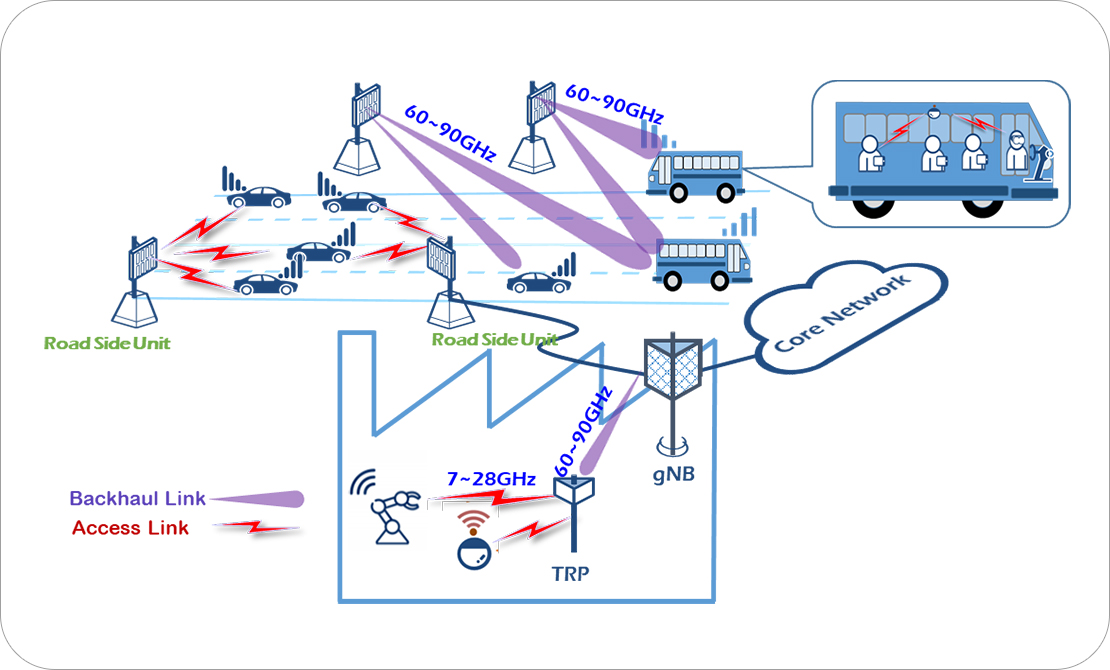
High-Capacity & Ultra-Precise Wireless Access and Wireless Backhaul Testing Overview: Conceptual Diagram (Test)
To support this, many view that a base station capacity of 100 Gbps or higher will be required. This is why it is necessary to secure wireless backhaul technology to provide a larger amount of traffic. So far, as an alternative for stations with increased capacities, technologies such as sub-terrahertz-based ultra-wideband wireless transmission with broadband support is garnering a lot of attention from the industry.
The research team of ETRI is now slowly pushing away from the previous ‘Best Efforts-Based’ data transmission technology, which was often pursued in the previous era of mobile communication, and is focusing on the development of a ‘High-Capacity Ultra-Precision Wireless Access Technology’ and ‘High-Capacity Mobile Wireless Backhaul Technology’ for a guaranteed ultra-precision service.
‘High-Capacity Ultra-Precision Wireless Access Technology’ refers to the core source component technologies in fields such as Absolute Time Synchronization, Diversity3), New Waveform4), and Multiple Antenna5), which are considered as key domains in order to realize the highest level of ultra-precision services while supporting large-capacity data transmission.
ETRI has successfully established a platform shared between such component technologies to verify the efficient Proof-of-Concept (PoC) of wireless access component technologies developed so far, and is now carrying out standardization activities to incorporate these technologies into the 3GPP mobile communication standards.
‘High-Capacity Mobile Wireless Backhaul Technology’ refers to a wireless backhaul-based network with a broadband frequency transmission technology for backhaul links that can expand the coverage of large-capacity services in mobile environments.
The researchers of ETRI have successfully developed an ultra-wideband, ultra-high frequency-based outdoor long-distance wireless backhaul testing device to verify the mobile wireless backhaul technology, also seeking to evaluate the performance of the technology when mounted on a vehicle.
The synchronization technology for absolute time synchronization developed in this study has been published in ‘IEEE IoT-J’, a well-renowned top 2% SCIE journal6).
Ko Young-Jo, a director at 6G Wireless Technology Research Section, ETRI, said, “Our goal is to lead the development of ultra-precision, large-capacity key enabling technologies that are needed for the implementation of 6G mobile communication services. With the technologies developed through this project, we will contribute to enhancing the competitiveness of Korea’s future mobile communication industry by dramatically improving communication quality, while also laying a solid foundation and providing a series of high-quality infrastructure for future technologies.”
This study has been carried out as part of the ‘ETRI R&D Support Project,’ supported by the Ministry of Science and ICT and the Institute for Information & Communication Technology Planning & Evaluation (IITP).
Glossary
1) Ultra-High Frequency Band: An electromagnetic wave with higher frequencies than your typical high frequency bands. Frequencies between 3 GHz ~ 30 GHz.
2) Absolute Time Synchronization: Refers to a technology that allows devices on a wireless network to have the same time/clock.
3) Diversity: A method that is used in wireless communication to reduce irregular changes and spikes in signal width/phase/etc., in the received signal.
4) New Waveform: A new type of radio/wireless signal used to send and receive data more efficiently in a wireless environment.
5) Multiple Antenna: A technology that improves the performance of communication by utilizing multiple transmission/reception antennas.
6) Published Paper (https://ieeexplore.ieee.org/abstract/document/9953954): Synchronization under hardware impairments in over-6-GHz Wireless industrial IoT systems
Ko Young Jo, Director
6G Wireless Technology Research Section
(+82-42-860-4810, koyj@etri.re.kr)
News 3
ETRI Protects Public Safety from Illegal Drones
- Successful Development of EO/IR-Linked Radar for Illegal Drone Detection and Tracking
- Technology Transferred to Samjung Solution Co., Ltd., Commercialization Nearly Complete
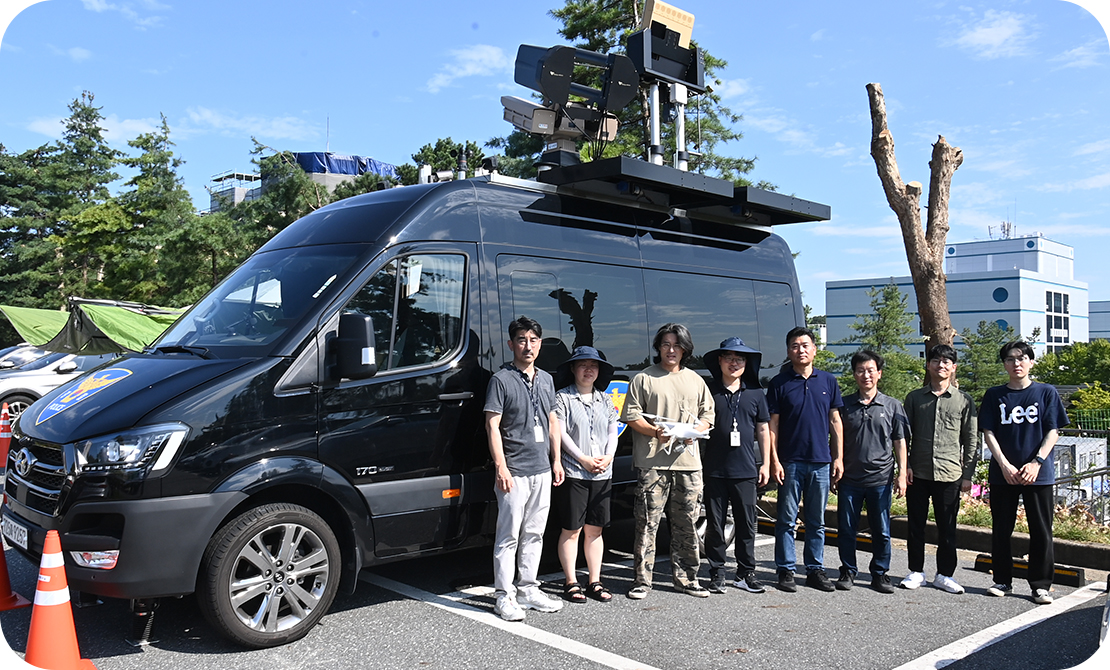
A South Korean research team has succeeded in developing a new technology that can detect and track illegal flying drones that cause crimes such as unauthorized flying, terrorism, privacy invasion, etc.successfully developed technology to detect and track illegal drones involved in crimes such as unauthorized flying, terrorism, and privacy invasion. This technology is expected to strengthen national security and enhance public safety against the threat of illegal drones.
Electronics and Telecommunications Research Institute (ETRI) announced that they have developed technology to detect and track illegal drones using an EO/IR (Electro-Optics/Infrared)1) linked radar system. The institute has successfully commercialized the technology by transferring it to Samjung Solution Co., Ltd., and it is now close to being deployed in the field.
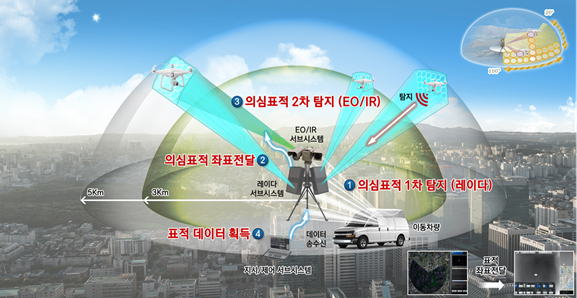
LADD(Low Altitude Drone Detection)2) System Configuration
ETRI’s EO/IR-linked radar technology for illegal drone detection and tracking is designed to detect, track, and identify incoming drones by automatically directing EO/IR sensors toward the target detected by radar. The system is based on a radar subsystem and an EO/IR subsystem.
The radar subsystem was co-developed by ETRI and Hanwha Systems Co., Ltd., and is designed to detect small drones within a 5km radius using the Ku-band3), avoiding the X-band4), which is widely used for military purposes.
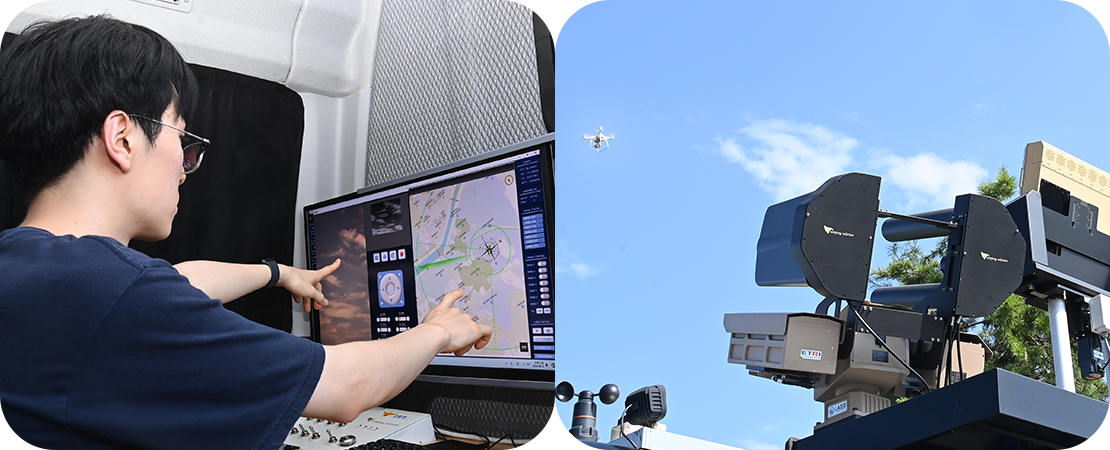
The EO/IR subsystem was independently developed by ETRI. This subsystem receives target information from the radar, uses an EO/IR camera to capture video footage of the target, and then detects, tracks, and identifies the drone based on that footage. The EO/IR subsystem can detect and track targets up to 3km away and can determine whether a flying object is a drone when it comes within 2km
.
Meanwhile, ETRI transferred this technology to Samjung Solution Co., Ltd. in 2022. Samjung Solution then commercialized the technology through the ‘Short-Term Security R&D Technology Commercialization Project,’ which ran from April 2022 to March 2024, as part of the ‘Police Technology Commercialization Project,’ which was led by the Ministry of Science and ICT and the Korean National Police Agency.
As part of this project, Samjung Solution developed an integrated solution for low-altitude unmanned aerial vehicles and successfully registered their ‘Vehicle-type Integrated Solution System,’ developed on July 18th, in the Nara Marketplace of the Public Procurement Service.
ETRI used this technology during the 2024 Ulchi Training for an illegal drone response exercise. On August 20th, the research team successfully detected and tracked a drone remotely as it attempted to infiltrate ETRI headquarters. Once the drone was within visual range, they confirmed its presence and successfully neutralized it by jamming5) its signals.
Through this training, it was confirmed that the illegal drone detection and tracking technology using ETRI’s EO/IR-linked radar system can be effectively applied in the actual field. With the successful development of this technology, ETRI is expected to contribute to strengthening national security and emerge as a leader in security and defense technology, protecting the safety of the nation and the public.
Cha Ji-Hun, Director of ETRI’s Autonomous UAV Research Section, stated, “Our EO/IR-linked radar system for illegal drone detection and tracking is an advanced technology that can respond quickly and accurately to external threats posed by illegal drones. This new technology is expected to play a pivotal role in enhancing national security and public safety. ETRI will continue to devote its efforts to developing innovative solutions that contribute to national security and public safety.”
Researchers involved in this project expect that this technology will be used in a variety of fields such as monitoring and surveillance for illegal drones at major events, public facilities, sports arenas, VIP protection, border patrol, coastline monitoring, drone traffic control, UTM-based facilities, and more.
This research was conducted as part of the ‘Policing Technology R&D Project,’ led by the Korean National Police Agency and the Korea Agency for Infrastructure Technology Advancement (KAIA) from 2017 to 2021. The specific project, titled ’Development and Field Demonstration Test of Surveillance System using radar and EO/IR for detecting illegal Flight of UAVs’ for the Security and Protection of VIPs and Key Facilities. 2017 to 2021.
Glossary
1) EO(Electro-Optics/InfraRed): An electronic device consisting of an electro-optical sensor and an infrared sensor, used to visually detect and track targets. The electro-optical sensor identifies targets using visible light, while the infrared sensor uses heat to detect objects that are not visible in regular light.
2) LADD(Low Altitude Drone Detection): A system specifically designed to detect and track illegal drones flying at low altitudes. The LADD consists of a radar subsystem, an EO/IR subsystem, and a control/indication subsystem.
3) Ku-Band: Refers to a frequency band between 12.0 GHz and 18.0 GHz in the electromagnetic spectrum, primarily used in fields such as satellite communication, Internet services, and video conferencing.
4) X-Band: Refers to a frequency band between 8.0 GHz and 12.0 GHz in the electromagnetic spectrum, commonly used in civilian radar systems, satellite communications, aviation, and military applications.
5) Jamming: A technology used to interfere with or confuse the operation of enemy electronic devices (such as GPS and communication systems) by disrupting their signals. This can significantly reduce the efficiency of the enemy’s information-gathering and weapon systems.
Injae Lee, Principal Researcher
Autonomous UAV Research Section
(+82-42-860-6639, ninja@etri.re.kr)
 Previous
Previous